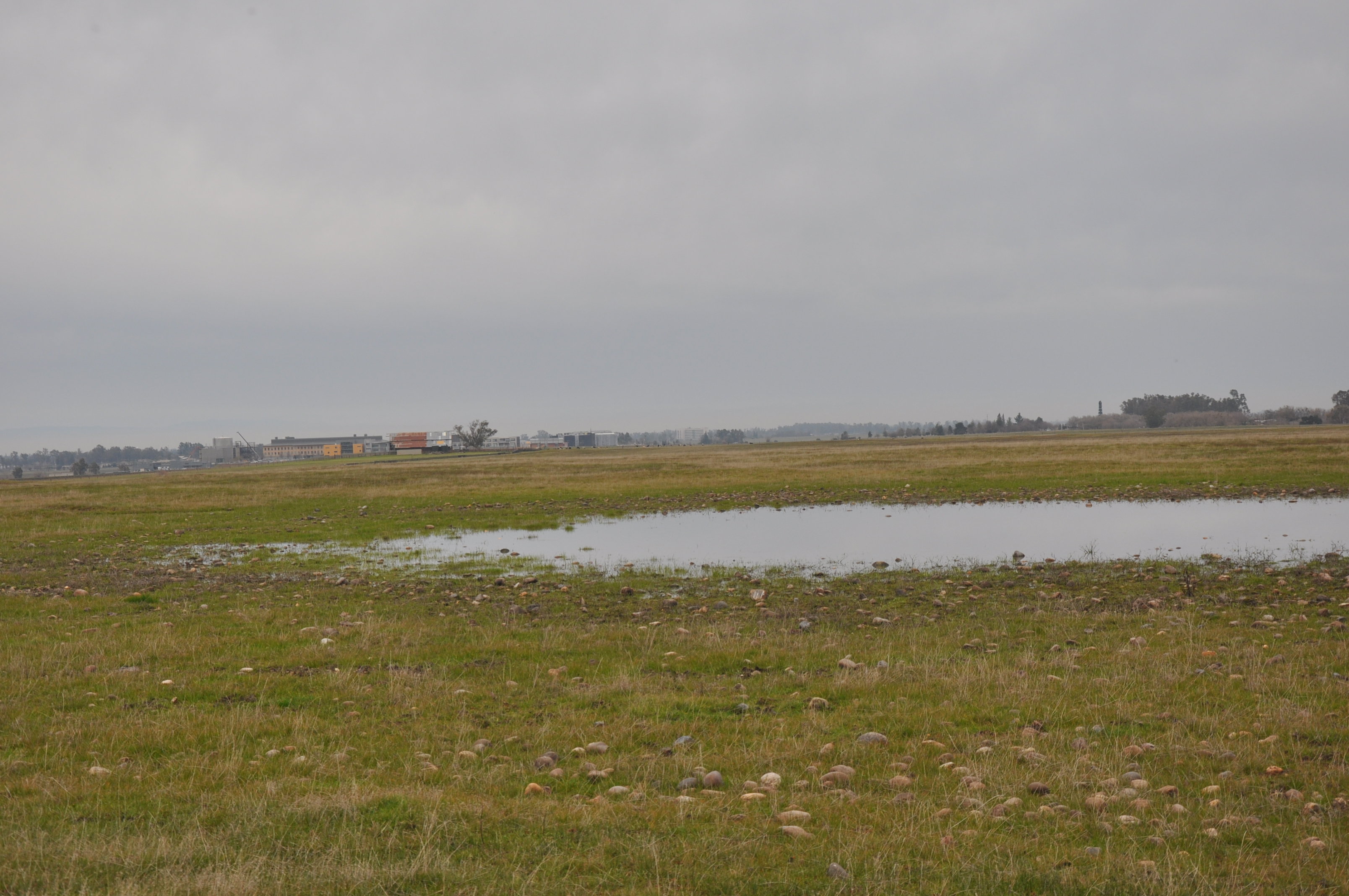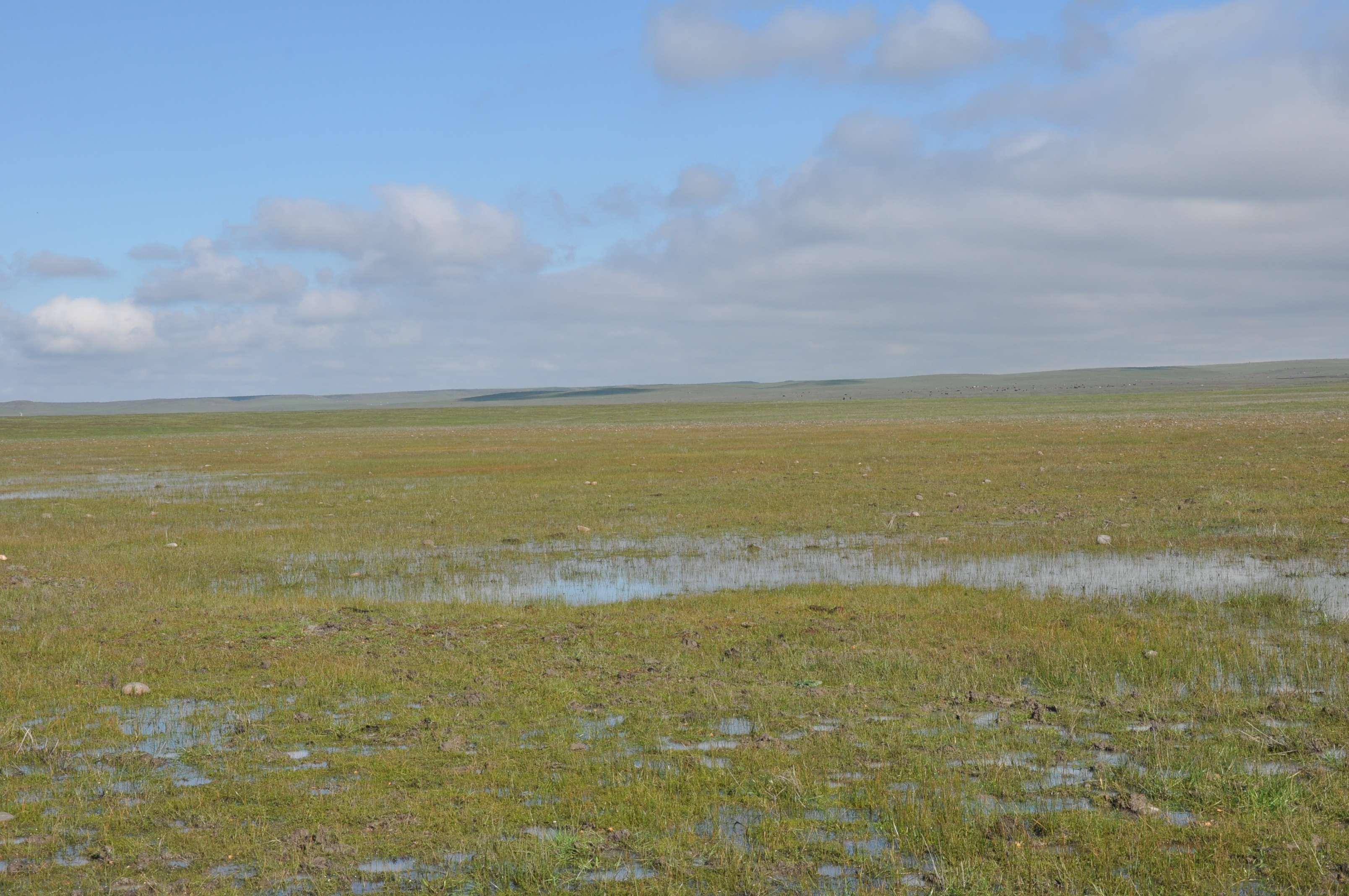Vernal pools are shallow, intermittently or seasonally flooded wetlands. Wetland ecologists refer to them as "seasonally astatic and episodic."
Like the name 'vernal' suggests, the pools begin to appear in late winter and spring after storms have dropped sufficient rainfall. Surface flow, rather than groundwater, is usually the main water source or process that provides the necessary inflow. The pools are ephemeral and for over half of the year they do not exist. During the heat of summer, however, the practiced eye can recognize subtle characteristics of soil color, dried vegetation, and exposed, rounded rocks that would indicate where the pools will develop months hence.
The pools predictably form in small permanent basins during the cool, wet part of the year, but during drought years like 2012 and 2013, the pools might not fill at all. These temporary pools are most often associated with flat lands or gently rolling hills that have mounded topography. If hills are flat topped, vernal pools may even be found on top!
Researchers have put forth the idea that tunneling by pocket gophers in loose alluvial soils creates small hills called Mima Mounds and that this in turn promotes the development of vernal pools! But much about the formation of vernal pools remains a mystery.
Jon Keeley and Paul Zedler, (1998) summarized the global attributes of vernal pools:
 ‘‘Vernal pools are precipitation-filled seasonal wetlands inundated during a period when temperature is sufficient for plant growth, followed by a brief waterlogged terrestrial stage and culminating in extreme desiccating soil conditions of extended duration.’’
‘‘Vernal pools are precipitation-filled seasonal wetlands inundated during a period when temperature is sufficient for plant growth, followed by a brief waterlogged terrestrial stage and culminating in extreme desiccating soil conditions of extended duration.’’
Zedler recognized that California pools pass through four distinct phases of existence:
- a pre-inundation wetting phase as seed germination and fairy shrimp hatching are stimulated by the first rains,
- a pool phase,
- a drying phase as the water evaporates and seeps away and the exposed substrate begins to dry,
- a summer desert-like dry phase
The vernal pools in eastern Merced County and adjacent areas in the San Joaquin Valley are found just above the valley floor where the foothills begin to rise slightly in elevation. When the rains do come to the San Joaquin Valley in the fall, the water that collects in the pools creates a critical haven for myriad life that evolved to depend on them.
Vernal pools are filled primarily by surface runoff from rain events, although groundwater might also contribute. Most pools measure 2 to 2,500 square meters and are less than 1/2 meter in depth. A layer of impervious soil, usually clay, called a duripan, prevents the accumulated water from percolating and draining into the underlying soils.
The UC Merced pools often have small rounded stones of various sizes resting at the bottom of the depressions, a good summer-time clue to their occurrence long after their waters have evaporated.
 One researcher commented rather dryly (pun intended), “For most of the year there is discordance between the name [vernal pools] and the observable state.”
One researcher commented rather dryly (pun intended), “For most of the year there is discordance between the name [vernal pools] and the observable state.”
Vernal pools are generally found in areas with a Mediterranean climate. Parts of Chile and Western Australia, as well as many areas of California, also have vernal pools.
Merced County pools can begin to fill in October, but this may be delayed until January if storms of sufficient duration or intensity do not travel east across the central part of the state. If the rains are 'too little, too late', the pools will not fill at all.
One or two modest rain storms are just not enough to fill the pools. It usually takes several sustained rains, each with at least 1/2 an inch or so of rain, to provide enough runoff.
Pools vary in depth from 10 cm to 60 cm, and size varies from 3 m to 50 m across. Small, brightly-colored wildflowers grow in concentric rings in and around the pools, each species having its own preferred location in the ring and its own specific period for blooming. The spectacular wildflower shows attracts droves of enthusiasts to nature preserves in the Central Valley.
Vernal pools might also be considered to be amphibious environments in that they alternate between being wet and dry. The nature of this aquatic habitat means the animals and plants that depend on the pools must be able to cope with dramatic seasonal changes in inundation. For example, aquatic invertebrates and amphibians such as salamanders and frogs must complete their life cycle before the pond dries. It also means eggs or larvae must be able to survive months of drying when the pools are empty.
Most vernal pools in our area are called Northern Hardpan Vernal Pools. They occur on old to moderately old acidic terraces. These terraces are the outwash of soils eroded from the high mountains to the east. The terraces have an underlying iron-silica cemented hardpan in the subsoil that prevents water from draining out of the pool. Without this character to the soil, the pools could not exist.
Researchers have also learned from studies on the Smith Trust lands adjacent to campus that the density of pools and the slope of the land are related to one another (Metz 2001).
The vast majority of pools – 97 percent -- occur on slopes of 2 percent or less. Steeper slopes - ever slight - experience erosional forces that would prevent vernal pools from forming.
As an example of the importance of slope, at the Merced- Mariposa County line, just 7 miles east of campus, the slope of the land has already become too steep to support vernal pools. Vernal pool density is also correlated with geologic surface. Density is highest on North Merced gravels and Riverbank surfaces; low on Mehrten surfaces- dark sandstone, claystone and conglomerates dating from the Pliocene ; and very low on Laguna, Turlock Lake and Modesto geological surfaces.


